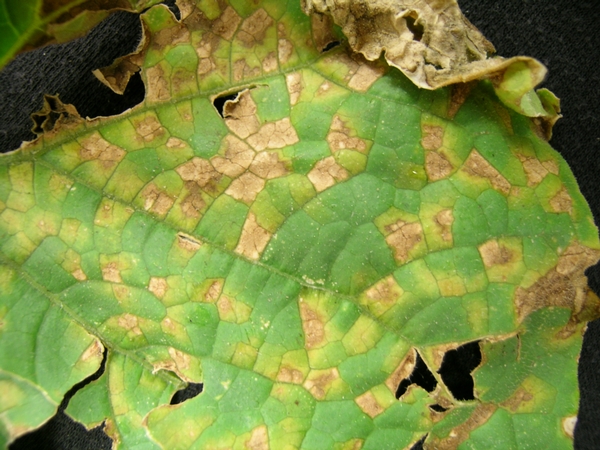Jul 8, 2019Cucumber downy mildew spores detected in Michigan
Our lab has established a network of spore traps in major cucumber production areas in Michigan. This year, we have the ability to distinguish between the spores of hop downy mildew and cucumber downy mildew. The spores of these two mildews look identical and in previous years we were not able to distinguish between them. This year, by using molecular tools, we know that up until this week, everything that we have trapped has been hop downy mildew. We got the first confirmation of cucumber downy mildew spores in Allegan County. While this is the first we have detected and the number is low, this is the time of year that we are on high alert for cucumber downy mildew disease.
Given the highly favorable weather conditions, the time of year and the first cucumber downy mildew spores, a spray with a protectant fungicide is advised. Examples of protectants that could be used include: Bravo (or another chlorothanil product), Zing! or Gavel. At this point, the disease has not been found or confirmed in the field. My lab will pick up suspect downy mildew samples in the state in order to verify whether it is downy mildew or a different disorder. We rely on vigilant scouts, growers, consultants and homeowners to help us detect early outbreaks so that we can alert others in the state.
Cucurbit downy mildew spores will be concentrated in areas where the disease is established. It is impossible to know where the first outbreak of downy mildew within any particular county may occur. A new infection may not register high spore counts, initially. Also, if a new downy mildew infection is not located near the spore trap, the spores will not be picked up by the trap until the disease becomes more widespread. Early detection and preventive fungicide treatment are the most successful approaches.
The spore counts to date can be found at the top of Hausbeck’s Downy Mildew News webpage listed under the Cucurbit Downy Mildew section as “2019 Downy Mildew Spore Trap Totals.” All confirmed outbreaks of downy mildew that will occur in the state will be marked by county on a map titled “2019 Cucurbit Downy Mildew Map” that is also listed on this page.
Onion disease recommendations
Onions are plagued by serious leaf blights caused by fungal pathogens including Stemphylium. An aggressive pathogen in Michigan for the last couple of growing seasons, Stemphylium is not readily controlled by the fungicide programs that limit purple blotch.
Stemphylium leaf blight has already been reported this year in an onion field. Left unchecked, this disease will significantly decrease yields and bulb size. If Stemphylium has been identified in your field, an aggressive fungicide program is needed. The weather continues to be highly favorable for disease and quick action with the most effective fungicides is advised.
Newly registered fungicides are important to protect plants from Stemphylium leaf blight and were evaluated last year under commercial conditions. The results from this study can be used to protect this year’s onions.
- First rating: Treatments of Quadris SC, Manzate Pro-Stick DF and Cabrio WG did not protect the foliage and these treatments had as much leaf blight as the unsprayed plants.
- Second rating: Disease progressed rapidly and the unsprayed plants had 76% of their foliage blighted.
- Third rating: Treatments of Quadris SC, Pristine WG and Tebuzol SC, Manzate Pro-Stick DF and Cabrio WG did not limit blight compared to the unsprayed plants. Luna Experience SC limited blight to less than 50%, produced the highest total yield, the lowest yield of small bulbs, and the highest yield of both medium and large bulbs.
- The following fungicides significantly limited foliar blight in the MSU trial:
- Aprovia Top EC (*FRAC: 3/7)
- Bravo WeatherStik SC (*FRAC: M05)
- Luna Experience SC (*FRAC: 7/3)
- Omega SC (*FRAC: 29)
- Quadris Top SC (*FRAC: 11/3)
- Tilt EC (*FRAC: 3)
*The FRAC code are numbers and letters assigned by the Fungicide Resistance Action Committee and are used to define the fungicide groups by their mode of action. M=multi-site inhibitors. Alternate treatment applications among products with different FRAC codes to delay the development of pathogen resistance. Visit http://www.frac.info/ for more information about FRAC codes.
– Mary Hausbeck, Michigan State University Extension, Department of Plant, Soil and Microbial Sciences
Photo at top: Downy mildew lesions on a cucumber leaf. Photo: Mary Hausbeck/MSU.

















